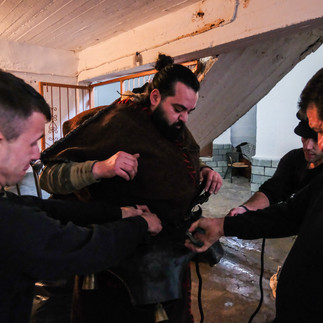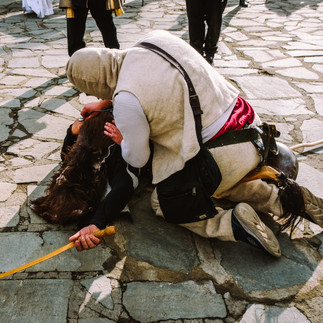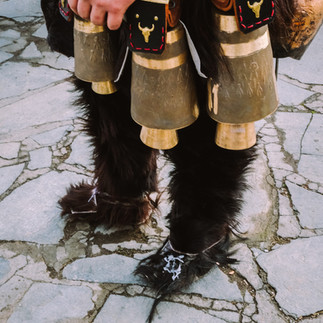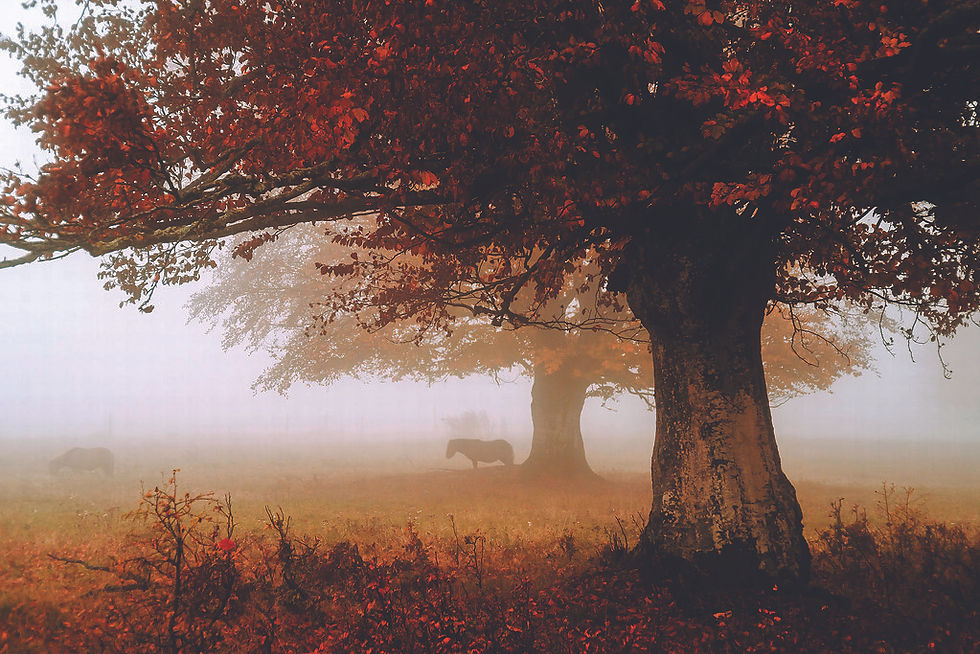Harapides of Pagoneri / Harapidi iz Pagonerija
- Анђела Петровски
- Jan 31, 2024
- 4 min read
Every year in Northern Greece, traditional Dionysian events take place over Christmas, from the 23rd of December to the 8th of January. Spanning back centuries, these activities, customs, and ceremonies have their roots firmly fixed in the traditions of this region and comprise key elements of the local culture.
Pagoneri (formerly known as Cheresovo) is a mountain village in the municipality of Kato Nevrokopi of the Regional Unit of Drama in Northern Greece. It has a population of fewer than 100 residents and it is built at an altitude of 670 meters on the northern slopes of Mount Falakro and west of the Nestos River. During the First Balkan War, the village temporarily came under Bulgarian control, while after the Second Balkan War, it passed to Greece.
Pagoneri is the most secluded village of all that celebrates the “Arapides” custom. The road as you enter the village has a row of ancient houses that are most of them two stories high and look as if they are going to fall. The Harapides custom kicks off around noon on January 6th, following the Epiphany. The village square transforms into a lively gathering with tables, local music, and a feast featuring roast sausages and boiled goat soup. Generosity reigns as villagers offer these delights and an abundance of wine to all attendees, although contributing a small donation to the village club is customary.
The Harapides, wearing scary masks crafted from goat skin and wielding wooden swords, create an atmosphere of excitement. Adding to the spectacle, there are additional characters, including the doctor called “Hatlis” with a pig skin headdress and an outfit which is made of lighter color fabric, he also has a wooden horse under his legs, the Bride, portrayed by a man in bridal attire and the Gypsy with her baby.
The uniqueness of Pagoneri's celebration lies in the participants portraying sickness or injury, collapsing unexpectedly during the festivities. Hatlis (doctor), rushes to heal the fallen. Visitors also attempt to playfully "kidnap" the bride or the Gypsy's baby, only to be pursued by the Harapides who are believed to be the bride's brothers. Those daring enough to participate in this playful mischief must pay a ransom once captured.
The festivities also involve a pause for rest and a visit to local fountains, where the Harapides aim to ward off satyrs from Greek folklore. These mischievous creatures believed to emerge during the twelve days of Christmas, are symbolically chased away to their underground dwellings.
In Pagoneri, joy, cheerfulness, and an unwavering connection to tradition are palpable during the Harapides celebration. The event not only entertains but also serves as a testament to the community's strong ties to its cultural roots. Visitors fortunate enough to witness these festivities gain a glimpse into the vibrant tapestry of Northern Greece's cultural heritage.
Photo and text by Manolis Soulos
Svake godine na severu Grčke, tradicionalni Dionisijski događaji odvijaju se tokom božićnih dana, od 23. decembra do 8. januara. Prožeti vekovima, ove aktivnosti, običaji i ceremonije imaju svoje korene u tradicijama ovog regiona i čine ključne elemente lokalne kulture.
Pagoneri (ranije poznato kao Čeresovo) je planinsko selo u opštini Kato Nevrokopi regionalne jedinice Drama na severu Grčke. Ima manje od 100 stanovnika i smešteno je na visini od 670 metara na severnim padinama planine Falakro i zapadno od reke Nestos. Tokom Prvog Balkanskog rata, selo je privremeno došlo pod bugarsku kontrolu, dok je posle Drugog Balkanskog rata prešlo u Grčku.
Pagoneri je najizolovanije selo od svih koje slave običaj "Arapides". Put kada ulazite u selo obložen je nizom veoma starih kuća, većinom dvospratnih, koje izgledaju kao da će se srušiti. Običaj Harapidesa počinje oko podneva 6. januara, nakon Bogojavljenja. Trg u selu pretvara se u živopisno mesto sa stolovima, lokalnom muzikom i gozbom na kojoj su pečene kobasice i kuvana supa od kozjeg mesa. Darežljivost vlada, jer meštani nude ova uživanja i obilje vina svim posetiocima, iako je uobičajeno doprineti malom donacijom klubu sela.
Harapides, noseći strašne maske izrađene od kože koze i mačeve od drveta, stvaraju atmosferu uzbuđenja. Kao doprinos spektaklu, postoje i dodatni likovi, uključujući doktora po imenu "Hatlis" sa kožnim pokrivačem za glavu i odelom napravljenim od svetlije tkanine, takođe ima drvenog konjića između nogu, nevestu, predstavljenu čovekom obučenim u svatovsku odeću, i Ciganku s detetom.
Jedinstvenost pagonerskog običaja leži u učesnicima koji prikazuju bolest ili povredu, kolabirajući neočekivano tokom svečanosti. Hatlis (doktor) žuri da izleči pale. Posetioci takođe pokušavaju igrajući "oteti" nevestu ili cigansko dete, samo da bi ih progonili Harapidesi koji se veruje da su braća neveste. Smeli ljudi koji učestvuju u ovom šaljivom zlostavljanju moraju platiti otkup kada budu uhvaćeni.
Svečanosti takođe uključuju pauzu za odmor i posetu lokalnim fontanama, gde Harapidesi ciljaju da oteraju satire iz grčkog folklora. Ova zlobna bića, za koja se veruje da se pojavljuju tokom dvanaest dana Božića, simbolično se progonе u njihova podzemna staništa.
U Pagoneriju, radost, veselje i nepokolebljiva veza sa tradicijom osećaju se tokom Harapidesove proslave. Događaj ne samo da zabavlja, već služi i kao svedočanstvo o snažnim vezama zajednice sa svojim kulturnim korenima. Posetioci koji imaju sreće da prisustvuju ovim svečanostima dobijaju uvid u bogatu i živopisnu tradiciju severne Grčke.
Photo and text by Manolis Soulos























































Comments